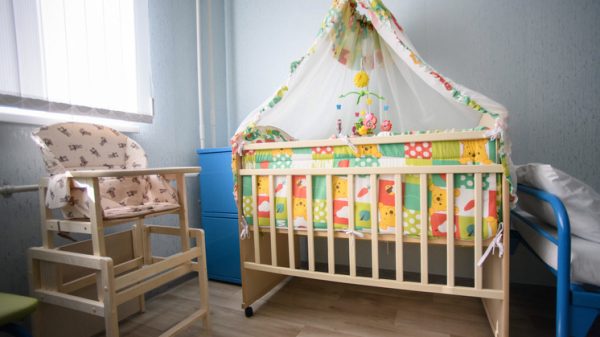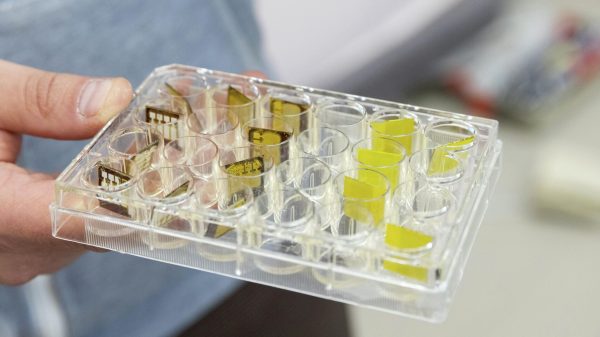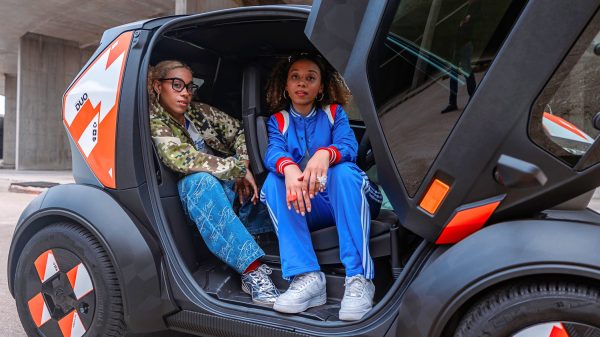Play Video
1:16
The world’s first raspberry-picking robot can pick 25,000 a day — video
Quivering and hesitant, like a spoon-wielding toddler trying to eat soup without spilling it, the world’s first raspberry-picking robot is attempting to harvest one of the fruits.
After sizing it up for an age, the robot plucks the fruit with its gripping arm and gingerly deposits it into a waiting punnet. The whole process takes about a minute for a single berry.
It seems like heavy going for a robot that cost £700,000 to develop but, if all goes to plan, this is the future of fruit-picking.
Automation threatens 1.5 million workers in Britain, says ONS
Read more
Each robot will be able to pick more than 25,000 raspberries a day, outpacing human workers who manage about 15,000 in an eight-hour shift, according to Fieldwork Robotics, a spinout from the University of Plymouth.
The robot has gone on trial in the UK, as the farming industry battles rising labour costs and Brexit-related shortages of seasonal workers.
Numbers of seasonal workers from eastern Europe have diminished, partly due to Brexit fears but also because Romania and Poland’s surging economies have persuaded their own workers to remain in their home countries .
The robot has been developed in partnership with Hall Hunter, one of Britain’s main berry growers which supplies Tesco, Marks & Spencer and Waitrose. Standing at 1.8 metres tall, the wheeled machine with its robotic arm has begun field trials in a greenhouse at a Hall Hunter farm near Chichester in West Sussex.
Guided by sensors and 3D cameras, its gripper zooms in on ripe fruit using machine learning, a form of artificial intelligence. When operating at full tilt, its developers say the robot’s gripper picks a raspberry in 10 seconds or less and drops it in a tray where the fruit gets sorted by maturity, before being moved into punnets, ready to be transported to supermarkets.
The final robot version, expected to go into production next year, will have four grippers, all picking simultaneously.
Separate field trials in China have shown the robot can pick tomatoes, and it has also been let loose on cauliflower.
As robots don’t get tired, they can pick for 20 hours a day, but the biggest challenge has been getting them to adapt to different light conditions, says Rui Andres, portfolio manager at Frontier IP, one of the main backers of Fieldwork.
Andres says UK farmers typically pay £1 to £2 for a kilogram of raspberries picked by human workers. Fieldwork intends to lease its robots to farmers for less.
The robot is the brainchild of Dr Martin Stoelen, a lecturer in robotics at Plymouth University, who moved from aerospace engineering into robots and took inspiration from his grandparents’ farm in Norway. By tackling one of the most difficult soft fruits first, he hopes to be able to tweak the technology so the robot can be used to pick other berries, fruit and vegetables.
Some growers have already expressed interest, under pressure from the rising minimum wage, with labour accounting for half of their costs. They have also been spurred into action by a decline in seasonal pickers coming from Bulgaria, Romania and Poland since the UK’s vote to leave the EU in June 2016. Berry and apple growers have been the hardest hit by the labour shortages, and farms have started poaching pickers from each other.
Many EU workers are staying away because their earnings have been eroded by the sharp drop in the value of the pound since the referendum.
Nicholas Marston, chairman of the British Summer Fruits (BSF) trade body, says fruit growers were 15%-30% short of seasonal pickers last summer. “It’s a struggle. There were definitely crop losses last year and the year before.”
Q&A What is AI?
Show
Hide
Artificial Intelligence has various definitions, but in general it means a program that uses data to build a model of some aspect of the world. This model is then used to make informed decisions and predictions about future events. The technology is used widely, to provide speech and face recognition, language translation, and personal recommendations on music, film and shopping sites. In the future, it could deliver driverless cars, smart personal assistants, and intelligent energy grids. AI has the potential to make organisations more effective and efficient, but the technology raises serious issues of ethics, governance, privacy and law.
Was this helpful?
Thank you for your feedback.
Under a new UK government-sponsored two-year pilot scheme, 2,500 berry pickers will be coming from Ukraine and Moldova, but this will not be enough to plug gaps, Marston says.
UK farms growing apples, berries and field crops need 70,000 seasonal workers a year. The berry industry alone employs 29,000, but BSF estimates it will need an extra 2,000 pickers by 2020, as people eat more berries. The National Farmers’ Union has recorded more than 6,000 unfilled vacancies on farms so far this year.
The UK is not alone – with a population shift from rural areas to cities, other European countries, the US and China are all struggling to attract enough seasonal workers to harvest their crops, so robots could be the answer in the long run.
Robots are also starting to be used for weeding and planting crops, and milking cows, as part of the long-term trend of automation in agriculture. The Small Robot Company, based near Salisbury, is trialling robots that look like spiders on wheels, called Tom, Dick and Harry. They seed, feed, weed and monitor field crops such as wheat in a gentler way than heavy farm machinery, reducing the need for water and pesticides.
Robots promise to raise productivity, at a time when UK productivity growth is lagging behind other countries. Analysts attribute this lack of economic efficiency to a shift towards more low-skilled jobs since the financial crisis, a lack of business investment and a decade of austerity.
If the rise of the robots materialises, it is expected to mainly affect low-skilled jobs. A new cohort of highly-skilled workers will be needed to maintain and debug the machines.
But Marston cautions: “It will be 10 years before robots will work as effectively as people.”




















































Свежие комментарии